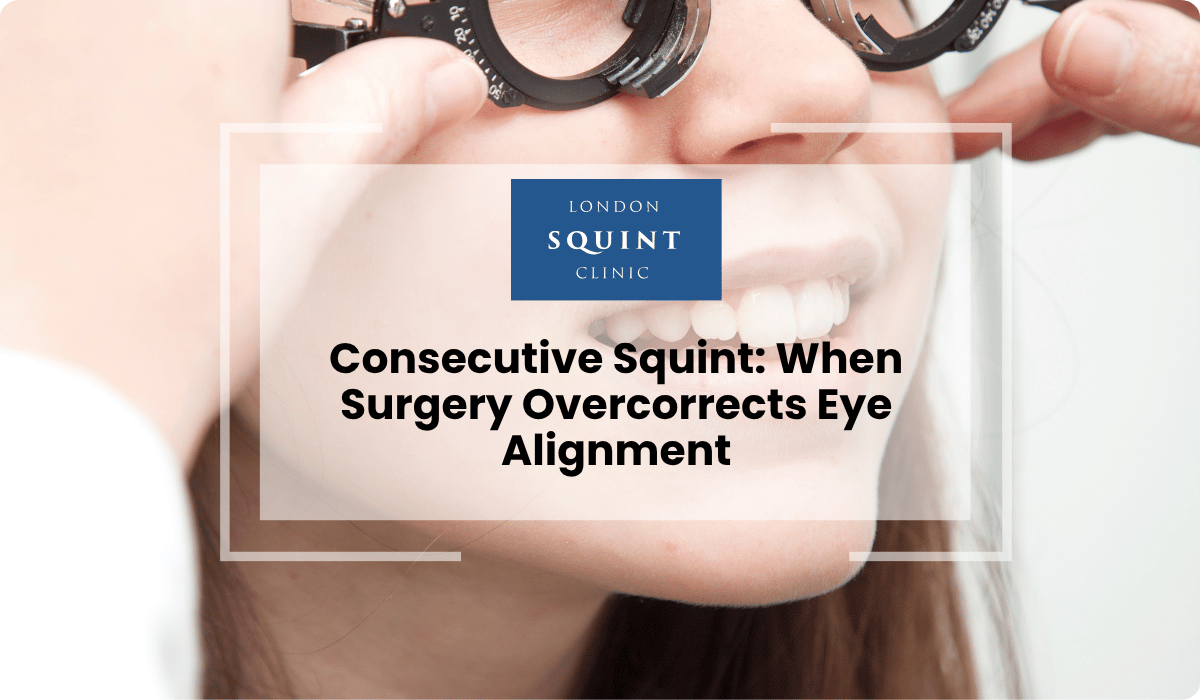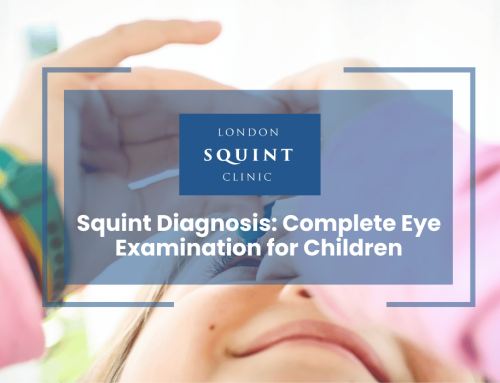Consecutive Squint: When Surgery Overcorrects Eye Alignment
Essential Insights for Parents of Children with Consecutive Squint
- Consecutive squint occurs in 5-20% of children after squint surgery, presenting as an eye misalignment in the opposite direction of the original condition.
- Early warning signs include visible change in eye turn direction, new double vision, unusual head postures, and difficulties with depth perception.
- Treatment options range from conservative approaches (glasses, prism lenses, orthoptic exercises) to reoperation, with decisions based on the severity of misalignment and the child’s age.
- Consistent adherence to prescribed treatments, environmental modifications, and clear communication with schools significantly improve management outcomes.
- With appropriate intervention, 70-85% of children achieve satisfactory alignment, though regular follow-ups until visual maturity are essential to prevent recurrence.
- Prompt treatment is particularly crucial for younger children whose visual systems are still developing to prevent permanent impacts on binocular vision.
Table of Contents
- Understanding Consecutive Squint: Causes and Identification
- How Does Squint Surgery Lead to Overcorrection?
- Signs Your Child May Have Developed a Consecutive Squint
- Diagnosing Secondary Squint After Previous Eye Surgery
- Treatment Options for Post-Surgical Overcorrection
- Managing Consecutive Squint in Children: Practical Steps
- When Additional Surgery Is Needed for Overcorrection
- Long-term Outcomes and Preventing Recurrence
Understanding Consecutive Squint: Causes and Identification
Consecutive squint refers to a secondary misalignment of the eyes that develops in the opposite direction to the original squint following corrective surgery. This condition typically manifests as an exotropia (outward turning eye) after surgery for esotropia (inward turning eye), or vice versa. It represents one of the more challenging complications in paediatric ophthalmology, affecting approximately 5-20% of children who undergo squint correction procedures.
The development of consecutive squint is multifactorial. Primary causes include surgical overcorrection, changes in the mechanical properties of the extraocular muscles following surgery, and alterations in the sensory fusion mechanisms that normally keep our eyes aligned. In children, whose visual systems are still developing, these factors can be particularly significant as their brains are actively establishing binocular vision pathways.
Identification of consecutive squint requires careful assessment, as it must be distinguished from a recurrence of the original condition or an incomplete correction. The hallmark feature is the reversal of the original deviation direction – for example, a child who initially had eyes turning inward (esotropia) may develop outward turning eyes (consecutive exotropia) after surgery. This directional change is key to diagnosis and subsequent management planning.
How Does Squint Surgery Lead to Overcorrection?
Squint surgery involves precise adjustments to the extraocular muscles to realign the eyes. Despite meticulous surgical planning, overcorrection can occur through several mechanisms. Understanding these factors is crucial for both prevention and management of consecutive squint.
The most common cause of overcorrection is excessive surgical adjustment of the eye muscles. During strabismus surgery, ophthalmologists must determine exactly how much to strengthen or weaken specific muscles. This calculation depends on measurements of the angle of squint, but these measurements can be challenging in children who may not cooperate fully during examinations. Even small miscalculations can lead to overcorrection, particularly in young children whose responses to muscle adjustments can be less predictable.
Another significant factor is the variability in healing responses. Each child’s tissue healing and scarring patterns differ, potentially altering the intended surgical effect. Muscle slippage or changes in the elastic properties of the muscles post-surgery can also contribute to overcorrection. Additionally, some children have underlying anatomical or neurological factors that predispose them to consecutive squint, such as high hyperopia (long-sightedness) or abnormal muscle insertion points.
The timing of overcorrection is also noteworthy. Some cases appear immediately after surgery, while others develop gradually over weeks or months as healing progresses and the visual system adapts to the new eye alignment. This delayed presentation can be particularly challenging to predict and prevent.
Signs Your Child May Have Developed a Consecutive Squint
Recognising the signs of consecutive squint early is essential for timely intervention. Parents should be vigilant for specific indicators that may suggest their child has developed this post-surgical complication. The most obvious sign is a visible change in the direction of the eye turn compared to the original squint. For instance, if your child’s eye previously turned inward (esotropia) and now turns outward (exotropia), this reversal strongly suggests consecutive squint.
Children may also report new visual symptoms that weren’t present before surgery. These can include double vision (diplopia), particularly when looking in certain directions, or complaints about objects “jumping” or moving when they shift their gaze. Some children might begin closing one eye when focusing, a compensatory behaviour to eliminate double vision. Headaches or eye strain, especially during close visual tasks like reading, can also indicate consecutive squint as the visual system struggles to integrate conflicting images.
Changes in head posture represent another important sign. Children may unconsciously tilt or turn their head to a position that minimises their double vision or helps align their eyes. Parents might notice their child adopting unusual head positions when watching television or reading. Additionally, a decline in depth perception might manifest as clumsiness or difficulty with activities requiring hand-eye coordination, such as catching a ball or pouring liquids.
It’s important to note that some degree of temporary misalignment immediately after surgery is normal and typically resolves during the healing process. However, persistent or worsening misalignment in the opposite direction from the original squint warrants prompt evaluation by an ophthalmologist.
Diagnosing Secondary Squint After Previous Eye Surgery
Diagnosing consecutive or secondary squint requires a comprehensive ophthalmological assessment that builds upon knowledge of the child’s previous condition and surgical intervention. The diagnostic process typically begins with a detailed history, reviewing the original squint type, surgical procedure performed, immediate post-operative alignment, and the timeline of any changes noticed since surgery.
The cornerstone of diagnosis involves precise measurements of eye alignment using various techniques appropriate for the child’s age and cooperation level. These may include the prism cover test, Hirschberg test, or Krimsky method. The ophthalmologist will measure the deviation in different gaze positions and at varying distances to fully characterise the nature and magnitude of the consecutive squint. These measurements are then compared with pre-surgical and immediate post-surgical values to confirm the diagnosis of overcorrection.
Assessment of binocular vision functions forms another crucial component of diagnosis. Tests for stereopsis (depth perception), fusion range, and suppression help determine how the visual system is adapting to the new eye alignment. In some cases, special imaging studies such as orbital MRI might be necessary to evaluate muscle positioning or identify any structural abnormalities that could contribute to the consecutive squint.
A thorough refraction assessment is also essential, as uncorrected refractive errors can influence eye alignment. Changes in prescription needs are common after squint surgery and may contribute to the development of consecutive squint. As discussed in our article on why some children need re-do squint surgery, accurate diagnosis guides the appropriate management strategy, whether conservative or surgical.
Treatment Options for Post-Surgical Overcorrection
The management of post-surgical overcorrection follows a stepwise approach, beginning with conservative measures before considering additional surgical intervention. Treatment decisions depend on several factors including the magnitude of the consecutive squint, the child’s age, visual status, and the presence of symptoms like double vision.
For mild cases of consecutive squint, especially those detected early, observation may be appropriate initially. Some overcorrections resolve spontaneously as the eyes adjust to their new position and the visual system adapts. During this observation period, regular follow-up examinations are essential to monitor for any changes in the deviation angle.
Optical correction forms the first line of active treatment. Ensuring the child wears an accurate glasses prescription is crucial, as refractive errors can exacerbate misalignment. In some cases, prism glasses for consecutive squint may be prescribed to realign the visual axes and alleviate double vision. These special lenses incorporate prisms that bend light to compensate for the eye misalignment, potentially eliminating the need for further surgery in mild to moderate cases.
Orthoptic exercises represent another non-surgical approach. These vision therapy techniques aim to strengthen binocular vision and improve the brain’s ability to fuse images from both eyes. Specific exercises may include convergence training, fusion exercises with specialised equipment, or computer-based vision therapy programs. While not suitable for all cases, orthoptic intervention can be particularly effective for smaller consecutive deviations with good potential for binocular vision.
For temporary management of symptoms, particularly in cases where the consecutive squint causes troublesome double vision, patching one eye may provide relief while more definitive treatment is planned. However, this approach is generally avoided in young children during their critical period of visual development to prevent amblyopia (lazy eye).
Managing Consecutive Squint in Children: Practical Steps
Managing consecutive squint in children requires a comprehensive approach that extends beyond clinical interventions to include practical strategies for daily life. Parents play a crucial role in this management process, serving as the primary observers of their child’s condition and facilitators of treatment adherence.
Establishing a consistent routine for prescribed treatments is fundamental. Whether this involves wearing glasses, using prisms, performing orthoptic exercises, or administering eye drops, consistency significantly impacts treatment success. Creating a reward system or incorporating treatment into daily routines can improve compliance, particularly for younger children who may resist eye exercises or glasses wear.
Environmental modifications can also support children with consecutive squint. Proper lighting reduces eye strain, while appropriate seating positions in classrooms and at home can minimise the need for challenging gaze positions. For children experiencing double vision, simple adaptations like using a reading guide or enlarged text may improve comfort during academic activities.
Communication with schools and activity leaders is essential. Educating teachers about your child’s visual condition ensures they understand any behavioural manifestations (such as head tilting or eye closing) and can provide appropriate accommodations. This might include preferential seating, additional time for visual tasks, or modifications to physical education activities that require depth perception.
Regular monitoring at home complements clinical assessments. Parents should observe for changes in the appearance of the squint, new compensatory behaviours, or complaints about vision. Keeping a simple diary of observations can provide valuable information for ophthalmologists during follow-up appointments. Additionally, supporting your child’s emotional wellbeing is crucial, as visible eye misalignment can sometimes lead to social challenges or self-consciousness, particularly in school-aged children.
When Additional Surgery Is Needed for Overcorrection
Despite conservative management efforts, some cases of consecutive squint require surgical intervention. Understanding when reoperation becomes necessary helps families prepare for this possibility and make informed decisions about their child’s care. Several key indicators suggest that additional surgery may be the most appropriate treatment option.
The primary indication for strabismus reoperation is a large-angle consecutive deviation that has remained stable for at least 6 months and has not responded adequately to non-surgical approaches. Generally, deviations exceeding 15-20 prism dioptres are less likely to resolve with conservative measures alone. Persistent double vision that significantly impacts daily functioning, despite trials of prism glasses or vision therapy, also strongly suggests the need for surgical correction.
Timing considerations are particularly important in children. If the consecutive squint is disrupting normal binocular vision development during the critical period (typically up to age 8-9 years), earlier surgical intervention may be recommended to restore proper alignment and prevent permanent visual deficits. Conversely, for older children with stable vision, surgeons might recommend waiting longer to ensure the eye alignment has completely stabilised.
The surgical approach for consecutive squint differs from primary squint surgery. It often involves adjusting the muscles previously operated upon, which requires special consideration of scarring and altered anatomy. In some cases, adjustable suture techniques may be employed, allowing fine-tuning of the alignment in the immediate post-operative period. This approach is particularly valuable in consecutive squint cases where precise correction is crucial to prevent under or overcorrection.
Pre-surgical planning includes detailed measurements of the deviation in all gaze positions, assessment of any restrictions in eye movement, and evaluation of the previous surgical reports. This comprehensive approach helps optimise surgical outcomes and reduces the risk of requiring additional procedures.
Long-term Outcomes and Preventing Recurrence
The long-term prognosis for children with consecutive squint is generally favourable when appropriate management strategies are implemented promptly. Studies indicate that approximately 70-85% of children achieve satisfactory alignment following treatment for consecutive squint, whether through conservative measures or reoperation. However, outcomes vary based on several factors including the child’s age, the magnitude of the deviation, the duration of misalignment before treatment, and the presence of amblyopia or other visual disorders.
Binocular vision outcomes deserve special consideration. Children who develop consecutive squint after their visual system has matured (typically after age 8-9) generally retain whatever level of binocular vision they had achieved before the overcorrection occurred. However, younger children whose visual systems are still developing may experience more significant impacts on binocular vision development, highlighting the importance of prompt intervention in this age group.
Preventing recurrence of consecutive squint requires ongoing vigilance and management. Regular follow-up examinations are essential, even after successful treatment, as eye alignment can change during periods of growth or with changes in visual demands. These appointments should continue until visual maturity is reached, typically in the late teenage years. Maintaining an accurate glasses prescription is also crucial, as uncorrected refractive errors can trigger recurrence of misalignment.
For children who have undergone reoperation for consecutive squint, specific post-surgical protocols may help prevent further complications. These might include temporary use of prism glasses during the adaptation period, structured orthoptic exercises to reinforce binocular vision, or in some cases, low-dose botulinum toxin injections to fine-tune muscle balance.
Parent education forms a cornerstone of long-term management. Understanding the warning signs of recurrent misalignment allows for early intervention if problems arise. These signs include intermittent double vision, return of abnormal head postures, or visible changes in eye alignment, particularly during fatigue or illness. With appropriate ongoing care and monitoring, most children with treated consecutive squint can achieve stable alignment and good functional vision throughout their lives.
Frequently Asked Questions
What is consecutive squint and how common is it after eye surgery?
Consecutive squint is a secondary eye misalignment that develops in the opposite direction of the original squint following corrective surgery. It typically appears as an outward turning eye (exotropia) after surgery for an inward turning eye (esotropia), or vice versa. This complication affects approximately 5-20% of children who undergo squint correction procedures, making it a relatively common post-surgical concern in pediatric ophthalmology.
How can parents recognize if their child has developed consecutive squint?
Parents should watch for: a visible change in eye alignment direction compared to the original squint; complaints of double vision; closing one eye when focusing; unusual head tilting or turning; headaches during visual tasks; and decreased coordination or depth perception. Any persistent eye misalignment in the opposite direction from the original condition warrants prompt evaluation by an ophthalmologist.
Can consecutive squint resolve without additional surgery?
Yes, mild cases of consecutive squint can resolve without additional surgery, particularly when detected early. Conservative management options include: observation for spontaneous improvement, accurate prescription glasses, prism glasses to realign visual axes, orthoptic exercises to strengthen binocular vision, and temporary patching for symptom relief. These non-surgical approaches are typically tried before considering reoperation.
When is additional surgery necessary for consecutive squint?
Additional surgery is typically necessary when: the consecutive deviation exceeds 15-20 prism diopters; the misalignment has remained stable for at least 6 months; conservative treatments have failed to adequately correct the problem; persistent double vision significantly impacts daily functioning; or when the squint threatens normal binocular vision development in younger children (under 8-9 years).
What are the long-term outcomes for children with consecutive squint?
Approximately 70-85% of children achieve satisfactory eye alignment following treatment for consecutive squint. Long-term outcomes depend on the child’s age at onset, magnitude of deviation, duration before treatment, and presence of other visual disorders. Children treated before visual maturity (age 8-9) generally have better binocular vision outcomes. With appropriate management and regular follow-up until late teenage years, most children can achieve stable alignment and good functional vision.
How can parents help manage their child’s consecutive squint at home?
Parents can help by: establishing consistent routines for prescribed treatments (glasses, exercises, etc.); creating appropriate lighting and seating arrangements to reduce eye strain; communicating with schools about necessary accommodations; monitoring for changes in eye alignment or visual symptoms; maintaining regular follow-up appointments; and providing emotional support, as visible eye misalignment can sometimes cause social challenges for children.
What causes overcorrection during squint surgery?
Overcorrection during squint surgery can occur due to: excessive surgical adjustment of eye muscles; difficulties in obtaining accurate pre-surgical measurements, especially in young children; unpredictable individual healing and scarring responses; muscle slippage during recovery; changes in muscle elasticity post-surgery; and underlying anatomical or neurological factors such as high hyperopia or abnormal muscle insertion points. Some overcorrections appear immediately after surgery, while others develop gradually during the healing process.
Find out if you are suitable for Double Vision Treatment
Not everyone is eligible for double vision surgery.
Find out if you could benefit from this life-changing surgery by taking the quick self-suitability quiz below:
Our most popular procedures

Hello, I’m Nadeem Ali
I’m one of the few eye surgeons in the world with 100% focus on Squint and Double Vision Surgery.
I have 24 years of eye surgery experience, and worked for 13 years as a Consultant at London’s renowned Moorfields Eye Hospital.
In 2023, I left the NHS to focus fully on treating patients from across the world at the London Squint Clinic. You can read more about me here.
There’s lots of information on the website about: squint surgery, double vision surgery and our pricing.
The most rewarding part of my job is hearing patients tell me how squint or double vision surgery has changed their lives. You can hear these stories here.
Mr Nadeem Ali
MA MB BChir MRCOphth FRCSEd(Ophth)





